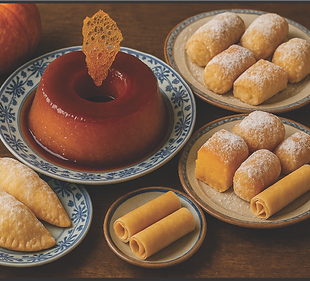
Explore the Universe of Itineraries We've Created for Your Private Trip
Traditional Conventual Sweets Tours
Embark on an irresistible tour of the convent sweets of northern Portugal, passing through Arouca, Amarante, Régua and Aveiro. A journey of authentic flavours, centuries-old traditions and recipes inherited from convents. Discover regional sweets in historic settings, where each stop is a unique experience of culture, pleasure and Portuguese gastronomic identity.

Conventual Sweets from the Minho Region
Convent sweets in the Minho region are a legacy of centuries of monastic tradition, marked by recipes passed down through generations of nuns and monks. Using simple ingredients such as eggs, sugar and almonds, unique sweets were created, such as the clarinhas de Fão, the papudos de Braga, the toucinhos-do-céu and the doces de Guimarães. Each convent left its mark, creating distinct specialities that endure to this day in regional bakeries. These sweets reflect the spirituality, refinement and creativity of the religious orders, and are today a symbol of Minho identity and a sweet expression of Portuguese cultural and gastronomic heritage.

Conventual Sweets Porto Region
The tradition of convent sweets in Amarante, Santo Tirso and Esposende is a treasure trove of Portuguese gastronomic heritage, rooted in the region’s ancient monasteries and convents. In Amarante, the highlights are the papos de anjo, the brisas do Tâmega and the rockets, sweets with a delicate texture and intense flavour, created by Dominican nuns. In Santo Tirso, the Jesuits have become local icons, representing the sweet legacy of the convent of São Bento. In Esposende, the clarinhas de Fão, filled with chila jam, evoke the subtlety and ingenuity of convent recipes. These delicacies preserve the memory, devotion and ancestral knowledge at the table.

Conventual Sweets in the Douro Region
The convent sweets of the Amarante, Vila Real and Mirandela region are a living testament to the cultural and spiritual richness of the northern interior of Portugal. In Amarante, the papos de anjo, raposas and brisas do Tâmega, created in female convents, reveal the nuns’ mastery in the use of sugar and egg yolks. In Vila Real, the toucinho-do-céu and pitos de Santa Luzia stand out, sweets of religious origin linked to local traditions. In Mirandela, although less convent-based, traditional sweets with monastic influences are still alive. This region preserves ancestral flavors that continue to sweeten festivals, pilgrimages and the collective Portuguese memory.

Conventual Sweets South of Porto
The region south of Porto, including Aveiro, Penacova, Tentúgal and Coimbra, is deeply marked by the tradition of convent sweets, a legacy of centuries of female monastic life. In Aveiro, the ovos moles, created by Dominican nuns, are a local symbol and Intangible Heritage. In Tentúgal, the famous Tentúgal pastries, with very thin dough and egg filling, reflect the refinement of the Carmelites. Coimbra, a spiritual and academic centre, preserves delicacies such as queijadas de Santa Clara and manjar branco. Penacova contributes with lesser-known sweets, but equally linked to religious traditions. This region holds a sweet, delicate legacy that is deeply rooted in history.